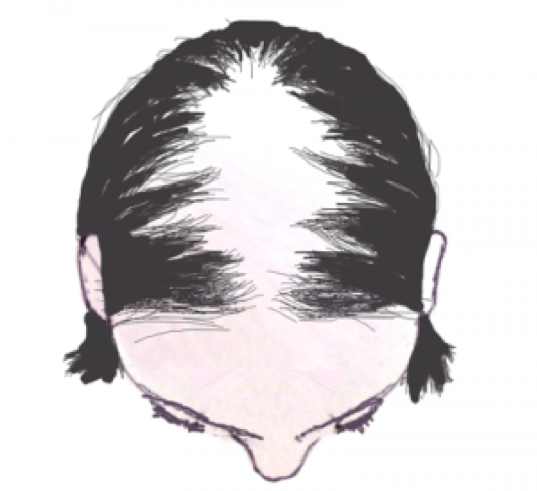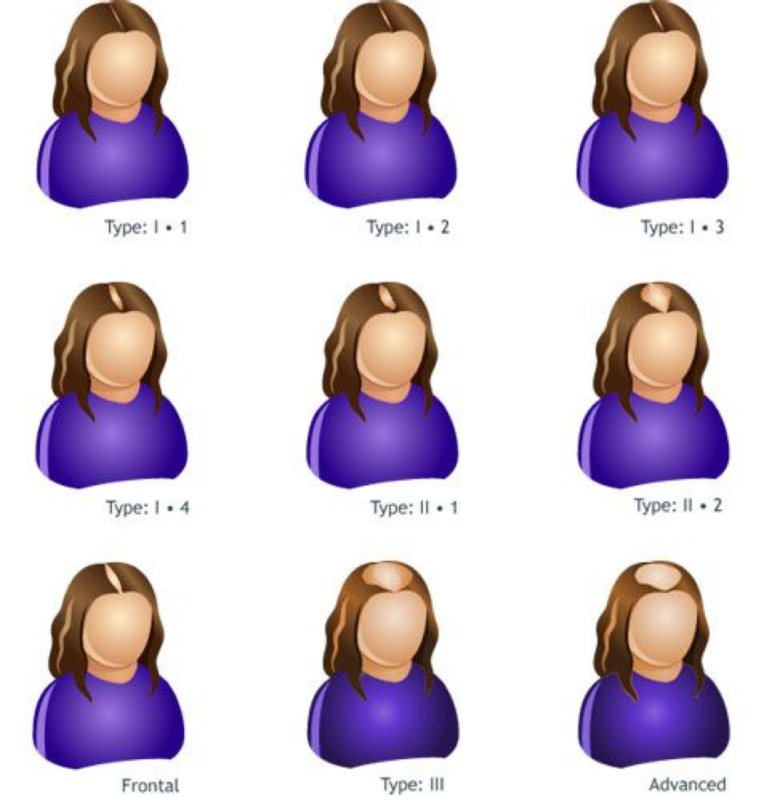‘Worldwide, women make up 14.2 per cent of all hair restoration patients.
Since 2004, the number of female surgical hair restoration patients has increased by 24 per cent.’
— International Society for Hair Restoration Surgery (ISHRS)
This staggering statistic only proves that hair loss is not a domain reserved only for men. Women may also experience thinning hair or hair loss at some stage in their lives. Approximately 80 per cent of women may exhibit noticeable signs of hair loss as they reach the age of 60.
30 million women suffer from hair loss in the USA
2.2 million women experience significant and measurable hair loss in Australia
If you think you are one of them, we want to share with you an easy way hair loss test to find out if you are thinning (a 60 second test) and then how you can classify the type of hair loss you have – the classification system between men and women is different as the pattern of thinning is different.
What is normal hair loss for a woman?
So, you’ve noticed a few extra hairs in your hair brush, or seeing more hair on the bathroom floor than normal (even in those seasonal times of apparent hair shedding), even worse, you have seen a lot of hair building up around the bathroom plug hole, and you’re feeling concerned. That’s a normal feeling and it’s not surprising – we can lose about 100 – 150 hairs a day. Which, when you think about it, isn’t a lot of hair given the average head of hair has over 100,000 hairs. As long as the loss occurs evenly across the scalp and hair are replaced at the same rate as they’re shed, that’s considered perfectly normal.
Did you know that the assumption we lose around 100-150 hairs a day is only based on the general assumption that scalps, on average, contain 100,000 individual hairs and that 10% of those hairs will be in the ‘telogen’ or ‘resting’ phase for three months before they fall out?
How to test for thinning hair – ‘the 60 second hair count’

There isn’t currently any standard method to assess the average number of hairs lost on a daily basis. The Archives of Dermatology recommends the ‘60 second hair count’ as a reliable way to assess how much hair is being shed.
The study involving 60 healthy men without evidence of male pattern baldness or alopecia areata, set out to define the range of normal hair loss count and determine if shedding remains constant with age.
Researchers devised a standardised 60 second hair count for assessing hair shedding. Half the men were aged 20 to 40, and half aged 41 to 60. The men participating in the study were all given the same shampoo and identical combs and told to wash their hair for three mornings in a row. On the fourth morning, before shampooing, they were instructed to comb their hair forward over a towel or pillowcase for 60 seconds. The men counted the hairs lost in this way for three consecutive days, with the procedure repeated after six months.
60 second Hair Loss Test produced consistent results
Men in the 20 to 40 years age bracket shed 0 to 78 hairs, with an average loss of 10.2 hairs per 60 second test. Men in the 41 to 60 years age bracket shed 0 to 43 hairs, with an average loss of 10.3 hairs per 60 second test. The results were consistent over the three day period and when the procedure was repeated six months later in both age groups, the hair count did not change much.
The research concluded the 60 second hair count to be a simple, practical and reliable tool for monitoring conditions associated with hair shedding and that dependable results over an extended period of time are obtainable.
“Studies of the 60 second hair count in normal women and in the setting of hair disease still need to be performed,” write the authors of the study.
The study has provided a benchmark for measuring hair loss but it’s important to consider all factors that can influence hair loss, including genetics.
As a result, the 60 second hair count has been deemed a simple and reliable way for men to monitor hair shedding. If you perform the test and are concerned about the number of hairs you have counted, it is advisable to seek a consultation with a hair loss expert to find out whether you have a hair loss condition, and what treatments are available.
If you are experiencing hair loss as a woman you probably want to go a little deeper than simply counting some hairs. If you are looking at solutions for your hair you need to define the extent of the hair loss you are experiencing. Keep reading to find out more about the various categories and ways to classify your hair condition.
The Three General Patterns of Hair Loss in Women
Female pattern baldness (FPB) or androgenetic alopecia is the most common type of hair loss in women. It is a distinctive form of baldness that is characterised by a receding hairline on the top and crown of the scalp while the front hairline remains unaffected except for normal recession. Below are three general patterns of female hair loss:
-
Christmas Tree Pattern of female hair loss

Frontal accentuation is a type of hair loss pattern that is commonly referred to as the ‘Christmas tree pattern’. The term was first coined by Dr. Elise Olsen, a dermatology specialist, who noticed that the hair loss resembled the shape of the base of a tree (at the hairline) and the tip of the tree (at the centre of the scalp). This is sometimes known as the Ebling-Rock scale and the Olsen scale of hair loss. This scale of hair loss isn’t used much these days as we have a more accurate way of classifying the various stages.
This type of thinning occurs as a result of Androgenic Alopecia. The degree of hair loss can be determined by the more refined and explicit stages of hair loss in the Ludwig and Savin Scale below.
-
Ludwig & Savin Scale pattern of female hair loss
There are several methods that help determine the phases of women’s hair loss, such as the Ebling-Rock scale and the Olsen scale (as previously mentioned). However, two of the most common methods used to create a uniformed analysis on the stages of female pattern baldness are the Savin scale and the Ludwig scale. These two scales are identical, the main difference is that the Savin scale also measures the hair density or the overall thinning of the hair.
The Ludwig and the Savin Scales both have a chart showing nine images of the same woman with a balding scalp in various stages of severity. The first image being the least severe and the last being the most severe.

A hair loss pattern that is demonstrated in the Ludwig Scale. This separates female pattern baldness in three unique stages or types, namely:
- Type I (Mild) — exhibits an early sign of thinning that may become noticeable when the hair is parted down the centre of the scalp. Most women who are in this stage of hair loss may have difficulty noticing the condition since the frontal hairline remains intact.
- Type II (Moderate) — shows a noticeable thinning, shedding and decrease of hair volume accompanied by a significant widening of the midline part that may broaden over time.
• Type III (Extensive) — characterised by a thin, see-through look on the top of the scalp that is usually associated with generalised hair thinning problem
-
Norwood-Hamilton Pattern of hair loss
A type of hair loss pattern that is similar to the pattern seen in men experiencing androgenic alopecia. Women experiencing this condition may exhibit recession of the hairline that resembles the Norwood-Hamilton Type II pattern of hair loss. The condition may progress to Norwood-Hamilton Type IV typically when women reach the age of 50 to 60. In very rare cases, this condition may progress to Norwood-Hamilton Type VI and VII.
Notably, female pattern thinning hair is subtle and unpredictable. Most women who experience hair loss often don’t even realise that they’re losing their locks until the condition has reached its advanced stage. It is quite common to have lost over 30% of your hair before any red flags are raised.
We also provide a range of clinically proven hair loss treatments for women that will restore the beauty of your crowning glory.
Proven Hair loss treatments for women.
Were you able to define which classification of hair loss best suits your situation?
Savin Scale – Type 1&2. We provide some wonderful hair products and treatments for those in Hair loss category. Most people in these stages want to preserve and prevent further hair loss whilst also seeking to make your hair look thicker both in the immediate term and longer term. In this situation we would recommend thinking about triple pronged approach.
- Biothik Hair Building fibres – Want instantly thicker hair! Of course you do. This product is no gimmick, it’s real, it’s proven and it works every time. Some have compared this product to a magic hair powder. They won’t grow your hair back, but it sure looks like it has. It’s perfect for an immediate boost to your hair, making it look thicker and fuller instantly with zero fuss. Take a look at the instantaneous results that can be achieved with it.
- Low Level Laser light therapy – this is a proven way to help regrow you hair and help to prevent further hair loss. Double blind clinical studies showed that on average women regrew and additional 20.4 new hair p/cm. That is equal to 149 hairs p/inch squared. Best case scenario, you can experience up to 50% additional regrowth from the baseline. 93% of people experienced hair regrowth and 85% noticed that hair loss ceased after use of the laser.
- Stem Cell Treatments – BioTHIK laboratories have spent many hours in research to produce a range of effective stem cell treatments for your hair. Studies showed that the ingredients in Folliplus serums helped to keep the hair in the growing phase (anagen) for longer and prevented hair aging.
Buy one, or, all of them today from our online store.
We ship globally and across Australia and New Zealand.
Australia, Sydney, Melbourne, Adelaide, Perth, Brisbane, Darwin, Hobart


